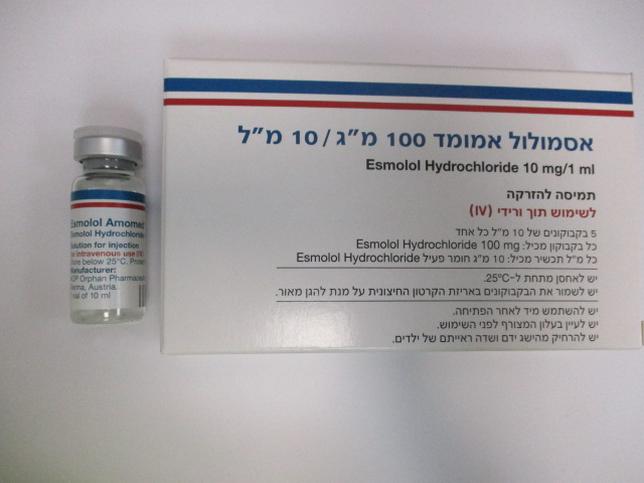Quest for the right Drug

אסמולול אמומד 100 מ"ג/ 10מ"ל ESMOLOL AMOMED 100 MG/10 ML (ESMOLOL HYDROCHLORIDE)
תרופה במרשם
תרופה בסל
נרקוטיקה
ציטוטוקסיקה
צורת מתן:
תוך-ורידי : I.V
צורת מינון:
תמיסה להזרקה : SOLUTION FOR INJECTION
עלון לרופא
מינוניםPosology התוויות
Indications תופעות לוואי
Adverse reactions התוויות נגד
Contraindications אינטראקציות
Interactions מינון יתר
Overdose הריון/הנקה
Pregnancy & Lactation אוכלוסיות מיוחדות
Special populations תכונות פרמקולוגיות
Pharmacological properties מידע רוקחי
Pharmaceutical particulars אזהרת שימוש
Special Warning עלון לרופא
Physicians Leaflet
Special Warning : אזהרת שימוש
4.4 Special warnings and precautions for use It is advised to terminate the infusion gradually because of the risk of rebound tachycardia. Esmolol hydrochloride should be used with caution in diabetics or in case of hypoglycaemia: The severity of hypoglycaemia is less than the one observed with less cardio-selective beta-blockers. The beta-blockers can mask the prodromal symptoms of hypoglycaemia such as tachycardia. Dizziness and sweating, however, may not be affected. The most frequently observed side effect is hypotension which is rapidly reversible with dosage reduction or discontinuation. In patients with a low systolic blood pressure, extra caution is needed when adjusting the dosage and during maintenance infusion. It is advised to continuously monitor the blood pressure and ECG in all patients treated with Esmolol. In the event of a hypotensive episode, the infusion rate should be reduced or, when necessary, be discontinued. Due to its negative effect on conduction time, beta-blockers should only be given with caution to patients with first degree heart block. The elderly should be treated with caution, starting witha lower dosage, but tolerance is usually good in the elderly. Beta-blockers may increase the number and the duration of anginal attacks in patients with Prinzmetal’s angina due to unopposed alpha-receptor mediated coronary artery vasoconstriction. Non-selective beta-blockers should not be used for these patients and beta 1-selective blockers only with the utmost care. Sympathetic stimulation is necessary in supporting circulatory function in congestive heart failure, and beta-blockade carries the potential hazard of further depressing myocardialcontractility and precipitating more severe failure. Continued depression of the myocardium with beta-blocking agents over a period of time can, in some cases, lead to cardiac failure. At the first sign or symptom of impending cardiac failure, Esmolol should be withdrawn. Although withdrawal may be sufficient because of the short elimination half-life of Esmolol, specific treatment may also be considered (see section 4.9). The use of Esmolol for control of ventricular response in patients with supraventricular arrhythmias should be undertaken with caution when the patient is compromised hemodynamically or is taking other drugs that decrease anyor all of the following: peripheral resistance, myocardial filling, myocardial contractility, or electrical impulse propagation in the myocardium. Despite the rapid onset and offset of the effects of Esmolol, several cases of death have been reported in complex clinical states where Esmolol was presumably being used to control the ventricular rate. Patients with bronchospastic disease should, in general, not receive beta-blockers. Because of its relative beta 1-selectivity and titratability, Esmolol should be used with caution in patients with bronchospastic diseases. However, since beta1-selectivity is not absolute, Esmolol should be carefully titrated to obtain the lowest possible effective dose. In the event of bronchospasm, the infusion should be terminated immediately and a beta2-agonist should be administered if necessary. If the patient already uses a beta2-receptorstimulating agent, it can be necessary to re-evaluate the dose of this agent. Esmolol should be used with caution in patients with a history of wheezing and asthma. In patients with psoriasis or a history of psoriasis, the administration of Esmolol hydrochloride should be carefully weighed as it should be done in any event. In patients with peripheral circulatory disorders (Raynaud’s disease or syndrome, intermittent claudication), beta- blockers should be used with great caution as aggravation ofthese disorders may occur. Beta-blockers may induce bradycardia. If the pulse rate decreases to less than 50–55 beats per minute at rest and the patient experiences symptoms related to bradycardia, the dosage should be reduced. Beta-blockers may increase both the sensitivity toward allergens and the seriousness of anaphylactic reactions. Infusions of concentrations of 20 mg/ml have been associated with significant venous irritation and thrombophlebitis in animals and man. Extravasation of 20 mg/ml may lead to a serious local reaction and possible skin necrosis. Local reactions have also been reported following infusion of concentrations of 10 mg/ml. Infusion into small veins or through a butterfly catheter should therefore be avoided. Use in the paediatric population (age under 18 years) The safety and effectiveness of Esmolol hydrochloride in children have not been established.
Effects on Driving
4.7 Effects on ability to drive and use machines Not relevant.

שימוש לפי פנקס קופ''ח כללית 1994
לא צוין
תאריך הכללה מקורי בסל
לא צוין
הגבלות
לא צוין
רישום
159 69 34872 00
מחיר
0 ₪
מידע נוסף
